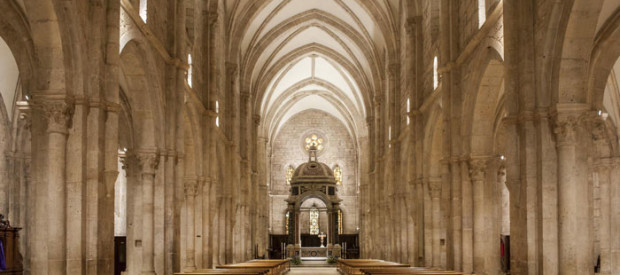
Montecassino Abbey
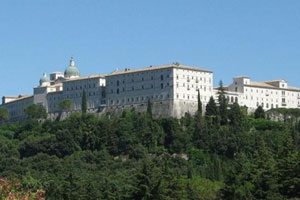 The Abbey of Monte Cassino was founded by St. Benedict for the monks around the year 529 on the ruins of two temples dedicated to Jupiter and Apollo. Its foundation favored, in the course of the century, a major urban development of the area.
The Abbey of Monte Cassino was founded by St. Benedict for the monks around the year 529 on the ruins of two temples dedicated to Jupiter and Apollo. Its foundation favored, in the course of the century, a major urban development of the area.The sanctity of the life of Benedict and his followers made it a religious center of great importance.
The house was destroyed by the invasion of the Lombard and then the monastery resources around 720. Early as the eighth century, the abbey was stated as an important center of culture. In the “scriptorium” many ancient works were transcribed and became one of the main centers of diffusion of writing Benevento.
After a period of abandonment, the monastery reached its zenith under Abbot Desiderius, in the second half of the eleventh century the monastery was reconstructed and a large basilica was consecrated in 1071.
During the year 1349 the monastery was severely damaged by an earthquake but was rebuilt from the sixteenth century to the eighteenth century. There were aspects of the late Renaissance but at the end of the renovation, the shape had an architectural style of the Baroque era.
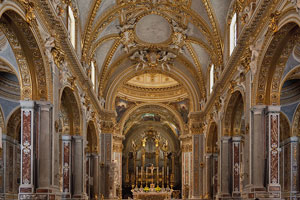 After the total destruction that took place on February 1944 as a result of the Anglo-American bombing caused by a hasty decision of the commands, mistakenly convinced that the monastery was turned into a German stronghold, a complex work of rebuilding the abbey has given the appearance original, according to its rectangular open design of the three cloisters of the sixteenth and eighteenth centuries, with the magnificent basilica with three naves, as per the original design.
After the total destruction that took place on February 1944 as a result of the Anglo-American bombing caused by a hasty decision of the commands, mistakenly convinced that the monastery was turned into a German stronghold, a complex work of rebuilding the abbey has given the appearance original, according to its rectangular open design of the three cloisters of the sixteenth and eighteenth centuries, with the magnificent basilica with three naves, as per the original design.
Placed on the high altar the relics of St. Benedict and St. Scholastica.
Its famous library, although severely compromised by the ravages of war, still preserves over 1.000 codes, 40.000 scrolls and the first official document of the vernacular the “Placito Capuano,” a judicial act which guaranteed the lands belonging to the monastery of Monte Cassino.
The library has been declared a national monument and falls within the category of public libraries. In addition, inside the Abbey, you can visit an interesting museum, where are preserved many works and artifacts of great quality and value, including: manuscripts, books, drawings and prints; remains of the Basilica, Etruscan and Roman art; wooden statuettes, Greek, Etruscan and Italic vases; Benedictine paintings and sculptures, embroidery and lace.
Carthusian Monastery of Trisulti
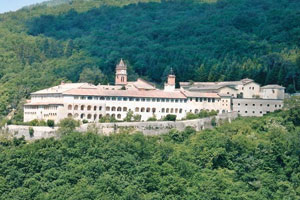 The Charterhouse of Trisulti, was built in 1204 by Pope Innocent III was then entrusted to the Carthusian monks until 1947 then they were replaced by the current Cistercians.
The Charterhouse of Trisulti, was built in 1204 by Pope Innocent III was then entrusted to the Carthusian monks until 1947 then they were replaced by the current Cistercians.Rich in precious artistic beauty, nestled in a lush vegetation rich of herbal medicines. Several buildings, boulevards and gardens make up the Certosa.
To visit: the Church, with frescoes by painters Verri, Caci, Balbi and decorated with a precious wooden choir of the sixteenth century and the Lodge that is in the Romanesque style.
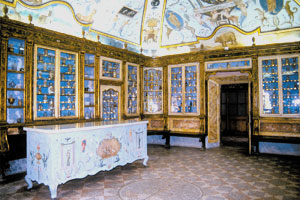 The pharmacy of the eighteenth century painted in the Pompeian style by G. Manco (still retains the containers used by the monks to distill herbs), and the adjacent sitting room frescoed by Balbi. The monks have collected herbs with which to prepare medicines, ointments, drugs who placed in clay pots majolica. These can still be seen well aligned in one of two lovely dining rooms. Still remains the production of traditional spirits. The pharmacy’s rooms are furnished with beautiful eighteenth-century wooden shelves, on which are exhibited boxes of beech and glass vases and ceramics.
The pharmacy of the eighteenth century painted in the Pompeian style by G. Manco (still retains the containers used by the monks to distill herbs), and the adjacent sitting room frescoed by Balbi. The monks have collected herbs with which to prepare medicines, ointments, drugs who placed in clay pots majolica. These can still be seen well aligned in one of two lovely dining rooms. Still remains the production of traditional spirits. The pharmacy’s rooms are furnished with beautiful eighteenth-century wooden shelves, on which are exhibited boxes of beech and glass vases and ceramics.The Charterhouse is a National Monument and also has a very rich State Library with 25,000 volumes.
The Way of Indulgences
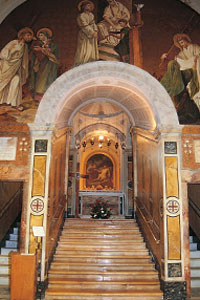 In the Basilica of Santa Salome in Veroli is the Scala Santa desired by the diocesan bishop, Monsignor Lorenzo Tartagni. He obtained from Pope Benedict XIV, the same privilege to the most famous “Scala Santa” of St. John Lateran in Rome.
In the Basilica of Santa Salome in Veroli is the Scala Santa desired by the diocesan bishop, Monsignor Lorenzo Tartagni. He obtained from Pope Benedict XIV, the same privilege to the most famous “Scala Santa” of St. John Lateran in Rome.
The Cathedral of Saint Andrew houses the Museum of the Treasury, which houses valuable relics, including a piece of the true cross, liturgical furnishings of the medieval goldsmith school.
The Basilica of St. Erasmus for his Eucharistic miracle.
A Boville Ernica, in the church of St. Peter of Spain, are preserved some remains of St. Peter’s Basilica as the Cross porphyry, adored by the faithful before the opening of the Holy Year, and the Angel of Giotto. The early Christian sarcophagus of the century. III – IV preserved here is a real treasure as unique in the world to be intact. It depicts two episodes of the Holy Bible.
In the Valley of Comino is the famous Shrine of Our Lady of Canneto (Settefrati) and, nearby, the “cradle of the Infant Jesus” (Gallinaro). A place of pilgrimage for many believers has become a place of gathering and prayer.
The Castle of Fumone - Celestino V
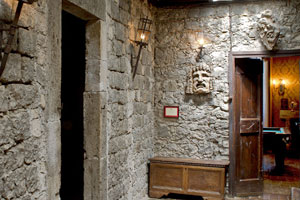 Fumone had, thanks to its geographical location, an important control function in its own territory sentinel against the Saracens and Normans.
Fumone had, thanks to its geographical location, an important control function in its own territory sentinel against the Saracens and Normans.It is thought that its name derives precisely from the fires that were lit on one of the towers when enemies were sighted. Hence the popular saying: “If Fumone smokes throughout the country trembles”.
In 1295, by order of Pope Boniface VIII was imprisoned, in the castle of Fumone, Celestine V (who had abdicated). Boniface VIII feared the authorities of Celestino V and his possible return to the papal throne.
Celestine died on May 19th 1296, according to some murdered at the behest of the same Caetani.
The fortress of Fumone today is a magnificent complex called “Villa Longhi” with the adjoining roof garden, from which you can dominate more than 40 countries; you can visit the chapel and the prison that housed Celestine V
In the church of S. Agata in Ferentino is venerated the relic of the heart of the holy pope.
The ghost of the Marquis child
In the castle were performed inhuman torture and still you experience the screams of the prisoners in the castle. But the most famous ghost of the castle is the Marquis Francesco Longhi only son and sole heir of the family Longhi. It is said that his seven sisters, not wanting to give up the riches family devised a terrible plan to kill the little Francis.
They put small pieces of glass in his food that brought him to have strong stomach pains. At the age of 5 he died and his mother did embalm him with wax in order to keep it close. His remains are on display in the castle.
It seems that every night the Marquis is delighted to move objects and make jokes.
Fossanova Abbey
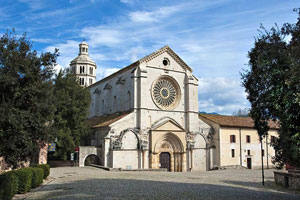 Fossanova Abbey is a Cistercian monastery in Priverno, in the province of Latina. The town has the appearance of a “vicus” (which in ancient Rome it was a cluster of houses and land, both rural and urban) and takes its name from a sewer. The abbey is a perfect example of the first Italian Gothic style, and few are the frescoes that are inside.
Fossanova Abbey is a Cistercian monastery in Priverno, in the province of Latina. The town has the appearance of a “vicus” (which in ancient Rome it was a cluster of houses and land, both rural and urban) and takes its name from a sewer. The abbey is a perfect example of the first Italian Gothic style, and few are the frescoes that are inside.The complex consists of the cloister, the fulcrum of the body, the church of Santa Maria, the Chapter House with overhanging dormitories of the monks, the refectory, the kitchen and the dormitory for the lay brothers, the home of the pilgrims, the cemetery and the infirmary.
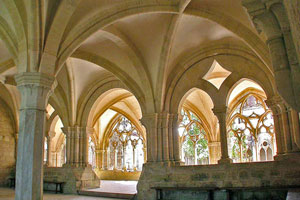 The infirmary is the room where he lived, prayed and meditated St. Thomas Aquinas in the last days of his life and where he died in 1274; still in church if it preserves the simple tomb empty because the body was moved by the Dominicans in Toulouse at the end of the fourteenth century. In one of the rooms of the abbey you can buy food products made by the monks as well as wines and spirits.
The infirmary is the room where he lived, prayed and meditated St. Thomas Aquinas in the last days of his life and where he died in 1274; still in church if it preserves the simple tomb empty because the body was moved by the Dominicans in Toulouse at the end of the fourteenth century. In one of the rooms of the abbey you can buy food products made by the monks as well as wines and spirits.
Sanctuary of the Santissima Trinità– Vallepietra
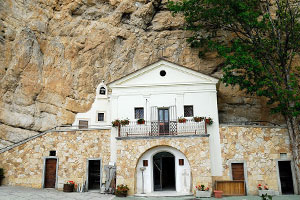 Vallepietra is a small medieval village with less than 400 inhabitants located in the province of Rome, near the border with Abruzzo and at the limits of the province of Frosinone.
Vallepietra is a small medieval village with less than 400 inhabitants located in the province of Rome, near the border with Abruzzo and at the limits of the province of Frosinone.In its territory lies the famous and ancient shrine of the Holy Trinity.
The hypotheses on the origin of the sanctuary are different. The best-known legend tells of a farmer who, while plowing his land on the “Hill of Tagliata”, saw his plow with two oxen fall into the precipice. Down in the valley miraculously he found alive the animals in front of a cave where there was a painting of the Holy Trinity, and the plow was stuck at the top in the rocky wall.
Thus began the ongoing pilgrimage by entire communities that still reach the shrine on foot.
The Feast of the Holy Trinity is the Sunday following Pentecost, while the Sanctuary is open from May to October.
Casamari Abbey
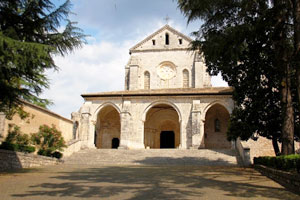 Along the way Mària, in the territory of Veroli, stands lonely in the shelter of a rocky hill. It was built on the ruins of an ancient Roman town dedicated to the goddess Ceres.
Along the way Mària, in the territory of Veroli, stands lonely in the shelter of a rocky hill. It was built on the ruins of an ancient Roman town dedicated to the goddess Ceres.The abbey of Casamari is a landmark in the history of Burgundian Gothic style in the early ‘200.
Despite the historical events, it has remained essentially intact in its original structure and is, along with Fossanova, one of the models of the best-preserved Cistercian architecture in Italy.
The plan of the building is similar to that of the French monasteries.
The complex is characterized by a very wide arched entrance which contains in its interior two arches of the Gothic style. The whole is surmounted by a loggia with four round-arched mullioned windows geminate.
At the exit of the hall, to the left, there is the elegant facade of the church with a rich portal, which overlooks the summit of a high staircase, preceded by a portico with three arches. The columns of Roman, aligned along the avenue, help to give solemnity and nobility to the complex. The interior has a Latin cross plan with three naves and a rectangular apse vault to the east, with six rectangular transept chapels, vaults supported by piers and columns, cabinets, architectural elements typical of the Gothic style. Unique ornament, the great eighteenth-century ciborium in polychrome marble and stucco that surmounts the altar, donated by Pope Clement XI.
From the square you can reach the Cloister Refectory (old Dispensarium) with the massive cylindrical columns, and the magnificent Chapter House with its three naves and the ribbed vault.
But the Abbey is also famous for the work of its monks and for its ancient Pharmacy which became a center of studies and preparation for pharmacists laity. Famous is the “elixir setterbe” and the ancient imperial. The abbey also houses a library with a collection of books about 80,000 volumes, and a rich art gallery with paintings of Carassi, Guercino, Sassoferrato, Balbi, Fantuzzi and Purificato.
Also to visit the Archaeological Museum which houses Roman furnishings.
Anagni- The city of the popes
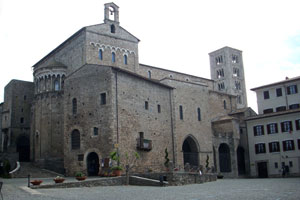 The city of Anagni is called “the city of the popes” because, in addition to being the birthplace of some popes (Innocent III, Gregory IX, Alesandro IV and Boniface VIII), it was their preferred place to stay especially in the twelfth and thirteenth centuries . Its cathedral was also the site of important historical events such as the “Pactum Anagninum”.
The city of Anagni is called “the city of the popes” because, in addition to being the birthplace of some popes (Innocent III, Gregory IX, Alesandro IV and Boniface VIII), it was their preferred place to stay especially in the twelfth and thirteenth centuries . Its cathedral was also the site of important historical events such as the “Pactum Anagninum”.In the Cathedral Alexander III excommunicated Emperor Frederick Barbarossa and Gregorio IV excommunicated Emperor Frederick II.
The town is especially linked to the name of Pope Boniface VIII ( Benedetto Caetani) born in Anagni in 1235.
He always had a special relationship with Anagni and by his actions the city has flourished. The Castello district was at the center of the most important historical moments.
The Palaces of Boniface VIII and of Traietto suffered violent attacks from the enemies of Pope Boniface VIII and lived the moments of the historic and famous “slap of Anagni” (or “outrage of Anagni”). It was an episode that occurred in the town in 1303 against Pope Boniface VIII. This story is one of the final acts of serious dispute that arose from the years between the pope and the king of France, Philip IV (called “the Beautiful”) to define the eventual supremacy of the spiritual over the temporal power, as called for by the pope himself.
The Cathedral
The construction of the Basilica of Santa Maria Cathedral of Anagni dates from the years 1072-1104 at the behest of St Peter Bishop from Salerno and the munificence of the emperor of the East Michael VII Ducas and is dedicated to Santa Maria Annunziata.
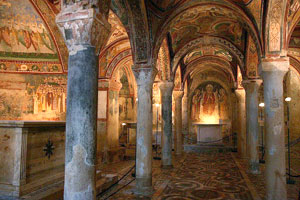 The style is Romanesque, while the interior, after restoration by the bishop Pandolfo, is in Lombard Gothic as the wooden beams of the nave and transept were replaced with Gothic arches.
The style is Romanesque, while the interior, after restoration by the bishop Pandolfo, is in Lombard Gothic as the wooden beams of the nave and transept were replaced with Gothic arches.
The Cathedral was the site of important historical events such as the “pactum anagninum” (negotiation between the Papacy and the Empire), the canonization of St. Bernard of Clairvaux, St. Clare of Assisi, Edward the Confessor (King of England) and St Peter hermit bishop of Trevi, the excommunication of the antipope Octavian Monticelli and against the emperors Frederick Barbarossa, Frederick II and Manfred.
The façade, with its raw wall, expresses strength and simplicity. In the western part there are three apses and a beautiful staircase. The bell tower is 30 meters high and has single-light mullioned windows. In 1938 was installed inside it, a castle of iron that supports the weight of five bays.
The Crypt
Dedicated to St. Albert the Great, patron of the city, the crypt of the cathedral is also known as the “Sistine Chapel of the Middle Ages.” The harmony of a commendable blend of Romanesque arches, the floor “cosmatesco”, original and beautiful frescoes covering an area of 540 m² making it one of the most beautiful and important crypts of Italy and Europe.
The paintings inside represent the history of man’s salvation from its origin to its judgment. They are, in fact, depict of scenes from the Old and New Testament but also a rare cycle on the scientific foundation of the world and of the man. On the walls are painted the stories of the miracles attributed to St. Magnus.
 English
English Italiano
Italiano 
